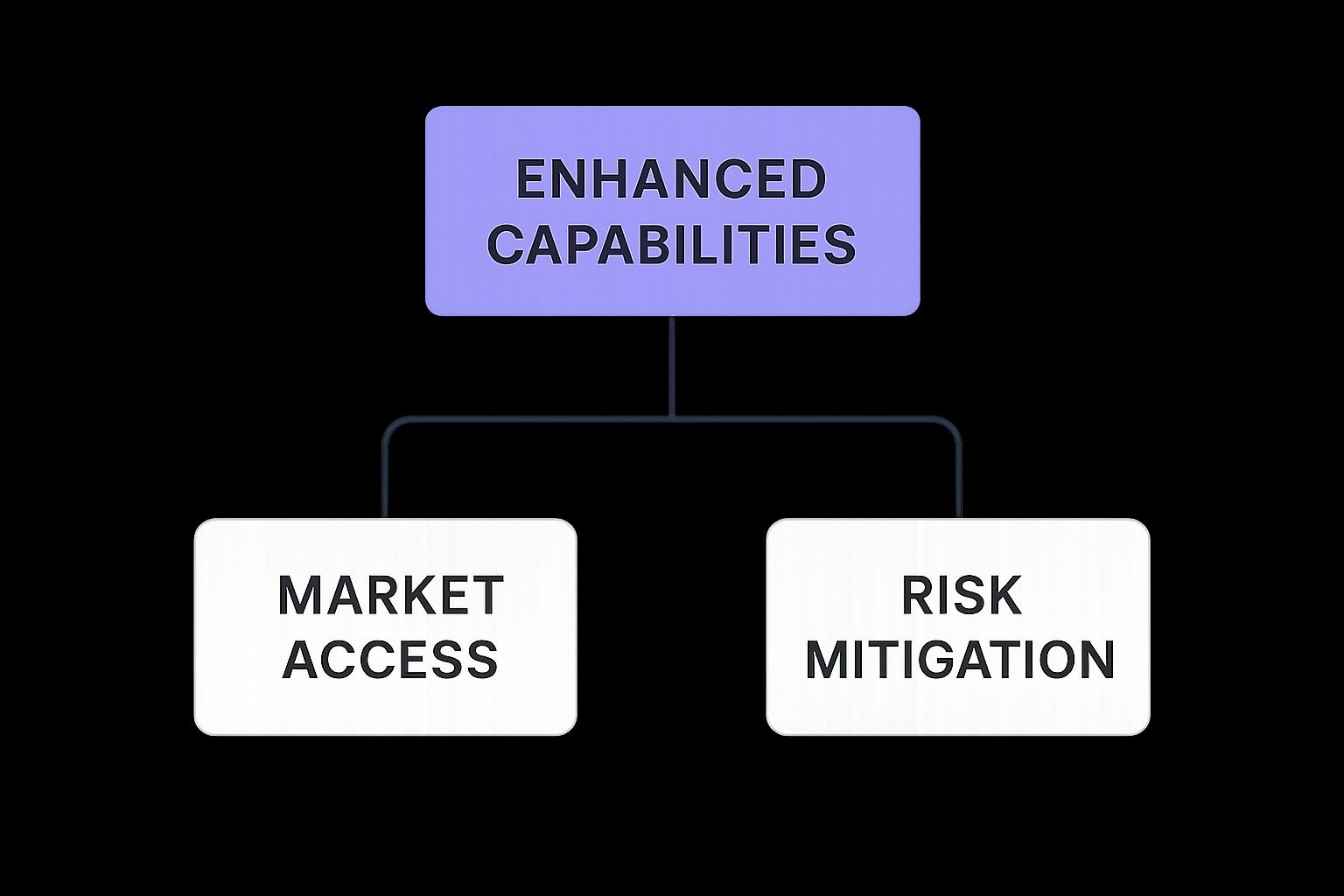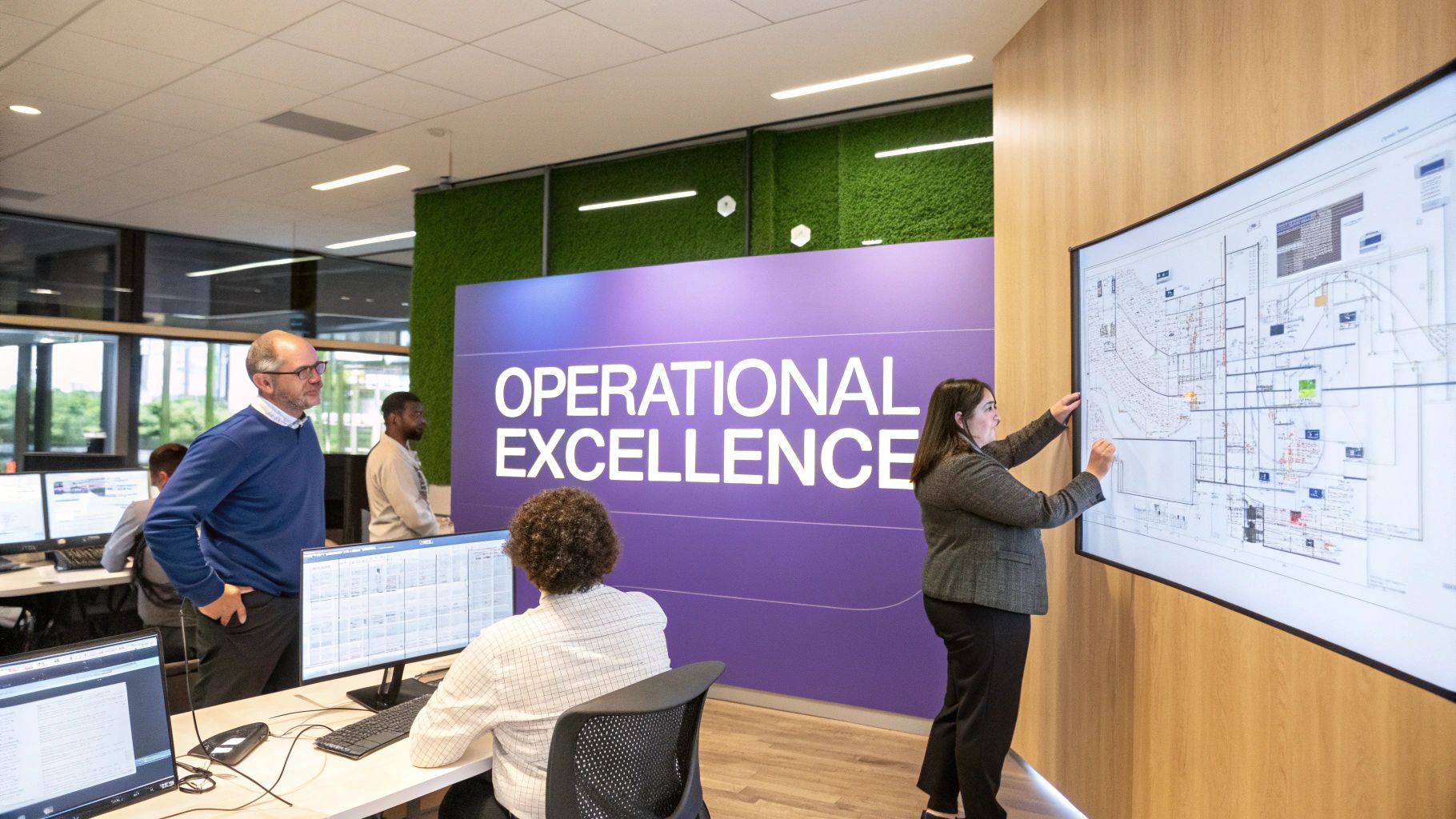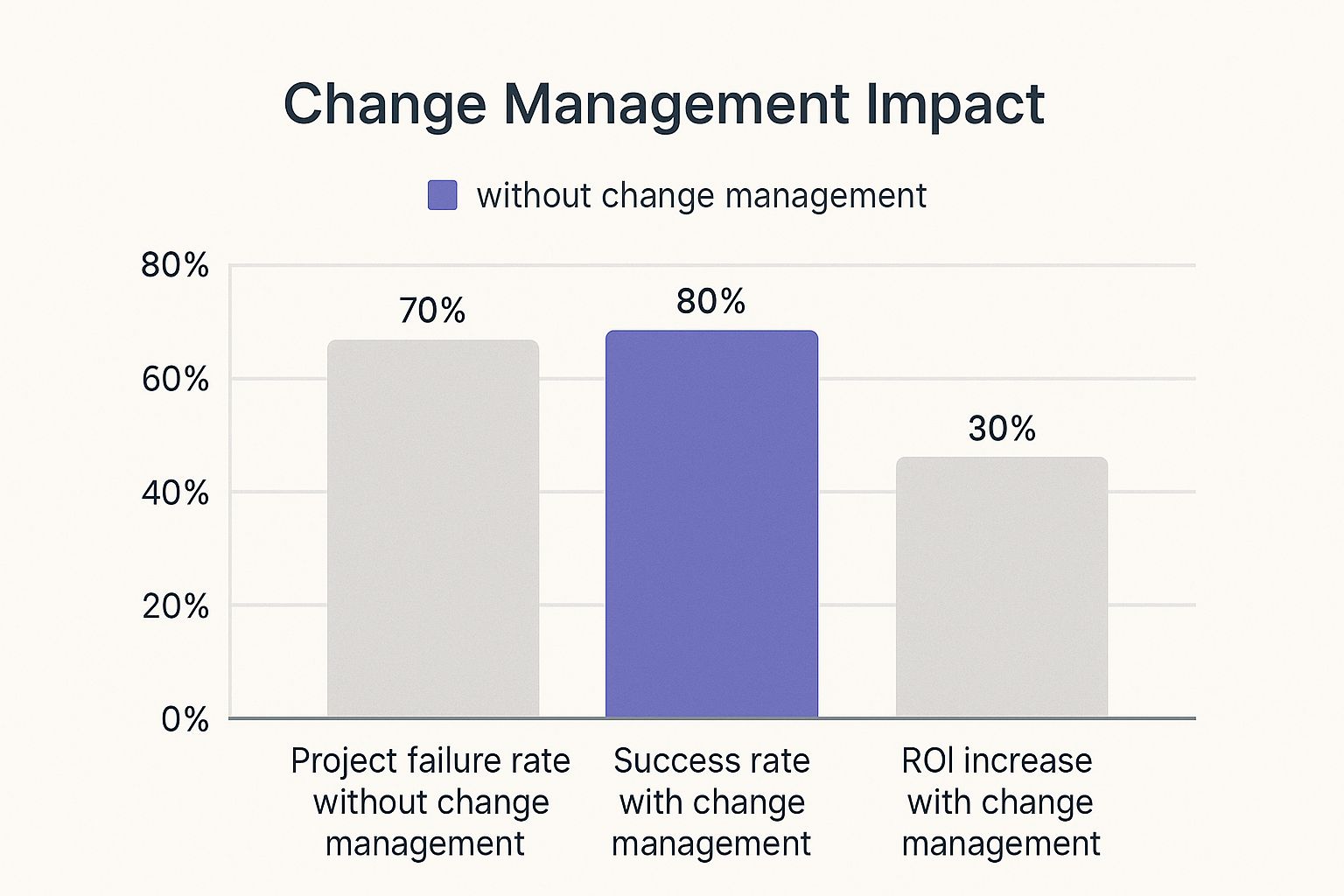We have all seen them. Strategic partnerships announced with fanfare, promising exponential growth and game-changing innovation. But what happens after the ink is dry on the contract?
The hard truth is that most falter. Not because the opportunity was not real, but because the management was absent. A handshake and goodwill are good starting points, but they will not sustain a valuable, complex collaboration over the long haul.
Why Most Business Partnerships Fail

Too many leaders treat partnerships like a "set it and forget it" appliance. They pour huge energy into the initial deal-making, then step back, assuming the whole thing will run on autopilot. This is a recipe for disaster.
Without a formal process, even the most exciting alliances can devolve into operational drag, draining resources instead of creating them.
We see partnerships as living extensions of your business. To thrive, they need a structured, people-first approach. It is about moving beyond occasional, ad-hoc check-ins and building a deliberate system for alignment, governance, and co-creation of value. That commitment to active management is what separates a simple business arrangement from a truly strategic one.
The Sobering Reality of Partnership Outcomes.
The data on alliance success is stark. Research consistently shows that around 60-65% of strategic partnerships fail. The culprits are usually the same. Misaligned goals, poor communication, or unrealistic expectations.
What’s worse? Nearly 39% of organisations admit to having no formal partner management strategy at all. It’s no wonder they struggle to steer these collaborations toward success.
This high failure rate is not because partnerships are a bad idea. It just highlights a massive gap between ambition and execution. When these collaborations fall apart, it is almost always due to the human elements, not a flaw in the business case.
A partnership is not just a contract. It is a relationship between two operational systems. If those systems, and the people within them, are not synchronised, friction is inevitable. True strategic partnership management is the art and science of keeping them in sync.
Moving from Reactive to Proactive Management.
An unmanaged partnership almost always descends into a series of reactive fire-drills. Misunderstandings brew, priorities drift apart, and the value you hoped to create slowly erodes.
Putting a formal management process in place flips this entire dynamic. It transforms the relationship from a source of constant headaches into a predictable, powerful asset.
The benefits of a structured approach are immediate.
- Clear Alignment. It forces everyone to work from the same playbook, with shared goals and a unified vision of what "success" actually looks like.
- Proactive Governance. It establishes who does what, who makes which decisions, and how conflicts get resolved. This prevents confusion and deadlock.
- Sustained Value. It creates clear ways to track mutual benefits, ensuring both sides stay invested and can see a tangible return on their effort.
Ultimately, effective strategic partnership management is about embedding a new capability within your organisation, not creating dependency. It builds a resilient framework that allows your collaborations to weather storms, deliver sustainable impact, and sharpen the focus of everyone involved.
Building Your Partnership Framework
Any partnership worth its salt is built on a solid foundation, not just a handshake and a hopeful idea. Without a clear framework, even the most promising collaborations can get tangled in misaligned goals and operational friction. Think of this as the practical blueprint for strategic partnership management.
At its core, a partnership framework is simply a shared agreement on how you will work together. It is a tool designed to bring clarity, ensuring both organisations are pulling in the same direction. It is what takes your collaboration from a signed contract sitting in a drawer to something that actually works day-to-day.
We have seen it time and again. Real success starts with people, not platforms. A partnership is no different. Your framework has to be designed around the people who will bring it to life, giving them a clear, practical structure to follow.
The Four Pillars of Alignment.
To build a structure that actually lasts, we focus on four key pillars. Each one answers a vital question about the relationship, cutting through ambiguity and fostering a shared understanding right from the start. These pillars ensure that the partnership’s capabilities are baked into its DNA, not just held by one or two key people.
We have summarised these four pillars below. They provide a simple, repeatable structure for defining how your partnership will operate.
Getting these pillars right from the beginning prevents future headaches and ensures the partnership has a strong foundation to build upon.
A framework transforms good intentions into reliable processes. It is the operational bridge between your shared vision and your shared success, ensuring that the partnership creates sustainable impact rather than administrative drag.
This infographic shows how the core benefits of a strong partnership framework connect to enhance your organisation's overall strategy.

As you can see, using partnerships to enhance your capabilities directly supports big-picture goals like expanding into new markets and better managing operational risks.
Making the Framework Actionable.
Creating a document is the easy part. The real work is making it a living part of your operational rhythm. This framework cannot be a static PDF filed away after one meeting. It must be a dynamic tool that guides joint planning, performance reviews, and strategic conversations.
To bring it to life, we recommend creating a Partnership Charter. This is a concise, practical document that summarises the four pillars and acts as the constitution for your collaboration.
Your charter should clearly define:
- The Joint Mission. A simple, one-sentence summary of your shared purpose.
- Key Contacts and Roles. A directory of who is responsible for what on both sides, from executive sponsors to daily operational contacts.
- Decision-Making Protocol. A clear outline of how decisions will be made, escalated when needed, and communicated to everyone involved.
- The Cadence of Communication. A schedule of regular meetings, from weekly tactical check-ins to quarterly strategic reviews.
Effectively managing this charter and all the knowledge it contains is crucial. You can learn more about this by exploring knowledge management best practices, which apply directly to partnerships. Building a central, accessible source of truth for your collaboration prevents miscommunication and keeps everyone aligned as the partnership grows and changes.
A Practical Implementation Guide

Finding a brilliant partner is a fantastic start, but it is just the first step. The real work, where potential gets turned into actual results, starts with implementation. A carefully planned, structured rollout separates partnerships that flourish from those that create friction and quietly fizzle out.
This is where we move from theory to action. Proper strategic partnership management is not about grand gestures. It is about a practical, step-by-step approach to bringing the collaboration to life. It is the methodical process of weaving the partnership into the day-to-day operations of both companies, ensuring it gets the resources and focus it needs to work.
Our philosophy is simple. We believe in building capability, not creating dependency. The aim is to create a self-sustaining collaboration that keeps delivering long after the initial buzz has faded. This guide lays out a clear path to do just that, giving you the confidence to launch partnerships that are not only effective but built to last.
Laying the Groundwork: Due Diligence and Joint Planning.
Before you can build anything, you need to be sure you are on solid ground. This phase is about getting deeply aligned and asking the tough, practical questions. It means looking beyond the high-level vision and getting into the detail of how you will actually work together.
Start with serious due diligence that goes beyond financials. What is their operational maturity like? How do they really make decisions? What is their track record with past collaborations? Getting these insights now helps you sidestep challenges before they become major problems.
Next up is joint business planning. This is not something you do in a silo. It is a collaborative effort where both sides sit down and co-create a detailed roadmap for success.
A robust joint business plan should cover:
- A 90-Day Launch Plan. What specific, concrete actions will you take in the first three months to get quick wins and build momentum?
- Resource Allocation. Who from each company is on the hook for this partnership? What percentage of their time is officially committed?
- Shared Technology and Systems. How will you share information? What tools will you use to track progress and manage joint tasks so nothing falls through the cracks?
Getting this stage right is critical for setting clear expectations and making sure both sides are on the same page about the effort required.
Operational Launch and Early-Stage Management.
With a solid plan in hand, the focus shifts to a controlled and carefully managed launch. This is not the time to just flip a switch and hope for the best. Think of it as a phased rollout, one that gives you room to learn and make adjustments as you go.
The first few weeks are all about establishing a communication rhythm. Regular, scheduled check-ins, at both operational and strategic levels, are non-negotiable. These meetings stop small misunderstandings from spiralling into major roadblocks.
A common pitfall is a lack of dedicated resources post-launch. A partnership without an owner is an orphan. It needs a designated manager who is empowered to solve problems, coordinate activities, and champion the relationship internally.
This is where a copilot approach can be incredibly valuable. Working side-by-side with your partner, especially in these early days, builds immense trust and fosters a genuine sense of shared ownership. It shifts the dynamic from a simple contractual obligation to a true collaboration, where both teams feel invested in each other's success. This kind of hands-on management ensures the partnership not only launches smoothly but also gathers the momentum it needs for the long haul. True strategic partnership management is an active, ongoing process, not a one-off event.
Measuring What Truly Matters
There is an old saying in business. "If you can't measure it, you can't improve it." This could not be more true for strategic partnerships. Vague feelings of ‘success’ will not cut it when you need to sustain momentum or justify the investment. You need real, objective metrics that show the value you are creating and provide the intelligence for sharper decisions.
Proper strategic partnership management means going beyond just looking at revenue figures. Fixating on a single metric can be deceptive. It might hide underlying problems or miss the broader impact of your collaboration. Instead, you need a balanced view that gives you the complete picture of your partnership's health.
It is about looking at the relationship from all angles. Are you bringing in new business? Fantastic. But are you also hitting key operational goals? Are you creating new things together? Asking these questions leads to a much more honest and robust evaluation of whether the partnership is delivering on its promise.
Beyond Revenue: A Balanced Scorecard.
To get a true measure of a partnership, you need a balanced set of Key Performance Indicators (KPIs). Think of it like a dashboard for your collaboration, a clear, at-a-glance view of how you are doing across different areas. This approach stops you from celebrating one metric while others are quietly failing.
A solid scorecard for a strategic partnership usually covers three main categories of metrics.
1. Financial Indicators
These are usually the most straightforward, tracking the direct commercial results of the partnership.
- Partner-Sourced Revenue. The most direct measure of financial success. This tracks the total sales that came directly from your partner’s leads or channels.
- Joint Customer Lifetime Value (CLV). Are the customers you gain through this partnership sticking around longer and proving more valuable than those from other channels?
- Cost Savings or Efficiencies. Put a number on the savings you have made through shared processes, pooled resources, or better economies of scale.
2. Operational Milestones
These metrics look at the health of the collaboration itself, focusing on how well you're working together.
- Integration Progress. Are you hitting your deadlines for key technical or process integrations? Track your progress against the agreed-upon timeline.
- Joint Service Delivery Performance. If you deliver services together, keep an eye on things like customer satisfaction (CSAT) scores or how quickly you resolve issues for joint accounts.
- Data Sharing and Security. With so much sensitive data being exchanged, tracking the security of these interactions is vital. A deep understanding of the role of cyber security in digital transformation is essential to protect both organisations.
3. Innovation and Growth Outcomes
These are your forward-looking indicators, measuring the partnership’s power to create future value.
- Co-Developed Products or Features. Count the number of new offerings or product enhancements you have built and launched together.
- New Market Penetration. How much ground have you gained in new customer segments or regions that were once out of reach?
- Knowledge Transfer. Are skills and insights actually being shared between your teams? This builds lasting capabilities for both sides.
A partnership dashboard is not just a reporting tool. It is a conversation starter. It surfaces difficult questions, highlights successes, and forces both sides to be accountable to the shared vision. It’s the engine of continuous improvement.
Choosing the right KPIs is only half the battle. Setting realistic targets for them is just as important. The goal is to build a simple, visible system that encourages transparency and allows you to make informed, data-driven decisions together. This shared understanding is what turns a good partnership into a great one.
Learning from Real-World Collaborations

Frameworks and theories are great, but nothing makes a principle click quite like seeing it in action. Effective strategic partnership management is not just an abstract idea. It is about the deliberate, practical steps people take to turn potential into real, measurable results. Let us look at two complex collaborations right here in the UK to see what this looks like on the ground.
These examples bring home how vital structured management is, whether the goal is cutting-edge academic research or tackling huge societal problems. They reveal universal truths about what makes partnerships succeed. Crystal-clear alignment, solid governance, and an unwavering focus on creating value for everyone involved. It is through these stories that you can see how a formal, thoughtful approach makes all the difference.
Case Study 1: International Alliances in UK Higher Education.
UK universities live by their international partnerships. These collaborations are essential for driving research, attracting top talent, and cementing their global reputation. But these are not simple handshake agreements. They are incredibly complex webs of different cultures, legal systems, and institutional goals. The real challenge is making them genuinely productive.
It has become a cornerstone of strategic partnership management, with a massive 79% of UK higher education institutions now baking these collaborations into their core international strategies. Here is a fascinating twist, though. There is no clear link between the sheer number of partnerships an institution has and how active or useful they actually are.
This small detail tells a big story. Success is not a numbers game of collecting partners like stamps. It is about actively nurturing a select, high-value few. The universities that get this right are the ones that:
- Define specific, shared research or teaching goals for every single partnership.
- Set up clear governance to handle tricky areas like joint funding and who owns the intellectual property.
- Invest in the relationship beyond the paperwork, building real human connections between academics and staff.
The lesson here is loud and clear. Quality over quantity, every single time. A well-managed portfolio of a dozen active partnerships will always outperform hundreds of dormant agreements left to gather dust. It is a powerful reminder to focus your energy where it will actually move the needle.
Case Study 2: Social Outcomes Partnerships in the UK.
For a compelling example of collaboration across different sectors, look no further than the rise of social outcomes partnerships. These are ambitious alliances where public bodies, private investors, and third-sector service providers join forces to tackle deep-rooted societal issues, from youth unemployment to chronic health problems.
These partnerships are a masterclass in steering diverse interests towards a single, shared goal. They demand exceptionally robust governance and a laser-focused definition of success, mainly because payment is often tied directly to hitting specific, measurable social targets.
The following data from the UK Government and the University of Oxford’s Go Lab gives you a sense of the scale and focus of these initiatives.
Social Outcomes Partnerships in the UK at a Glance.
This snapshot from the UK Government and the University of Oxford’s Go Lab illustrates the scale and focus of these complex multi-sector collaborations.
These figures show that these intricate partnerships are being deployed to solve some of the UK’s toughest challenges, which requires a huge degree of coordination and trust between vastly different organisations.
What makes them tick is a rigorous framework that includes constant performance monitoring, shared data systems, and often a neutral go-between to keep everyone on the same page. The hurdles these partnerships face often demand expert guidance to navigate, much like the support that business transformation consultants provide to align people, processes, and technology for a common purpose.
Both of these cases, from the halls of academia to the front lines of social policy, prove the same thing. Lasting success in any collaboration does not happen by accident. It comes down to the quality of its management, building a system that champions transparency, accountability, and a powerful, shared sense of purpose.
Frequently Asked Questions
When you are in the trenches of strategic partnership management, plenty of practical questions come up. Let us tackle some of the most common ones we hear from leaders, helping you move forward with more clarity.
What Is the Most Common Reason Strategic Partnerships Fail?
If there is one thing that sinks a partnership faster than anything else, it is a fundamental mismatch in objectives right from day one. When you do not have a shared, crystal-clear vision of what success looks like for everyone involved, partners inevitably start pulling in different directions.
This quickly snowballs into operational friction, a breakdown of trust, and, before you know it, the whole collaboration collapses. A solid framework forces you to have those tough, critical conversations early on, which can make all the difference.
How Do You Measure the Health of a Partnership Beyond Revenue?
While the numbers on a spreadsheet are important, they rarely paint the full picture. To get a real feel for how a partnership is doing, you need to look at the relationship itself.
- Stakeholder satisfaction. How do the teams on the ground actually feel? Regular, candid chats are the only way to find out.
- Non-financial milestones. Are you hitting the goals you set for things like product integrations or joint marketing campaigns? This shows real progress.
- Communication quality. Is the communication proactive and open, with both sides solving problems together? Or is it all just reactive firefighting?
These softer metrics give you a much richer view of the partnership's stability and its odds of succeeding long-term.
A partnership is not just a revenue stream. It is a living relationship built on trust and mutual effort. If the relationship itself is not healthy, any financial gains will be short-lived.
How Much Time Should Be Dedicated to Managing a Key Strategic Partner?
There is no magic number, but a classic mistake is drastically underestimating the time and effort required. For a really important strategic alliance, a dedicated manager might need to commit a huge chunk of their time, think 20% to 50%, just to keep things on track with joint planning, performance reviews, and relationship building.
The rule of thumb is simple. The time and resources you invest should match the value you expect to get out of the partnership.
This level of hands-on management is absolutely critical for complex collaborations, like the social outcomes partnerships we see across the UK. So far, 99 of these initiatives have been launched to tackle tough challenges like mental health and unemployment, delivering services to over 110,000 people. You can review the latest data on UK social outcomes partnerships to see just how these intricate collaborations are put together and funded.
When Is It Time to End a Strategic Partnership?
Knowing when to walk away is just as important as knowing when to start. It is probably time to call it a day when the partnership consistently fails to hit the goals you both agreed on.
Other massive red flags include a fundamental shift in strategic priorities for one or both organisations, or a complete breakdown in trust and communication that just cannot be repaired, even with genuine effort. When it comes to that point, a professional, structured off-boarding process is key to ending things respectfully and protecting both sides.











